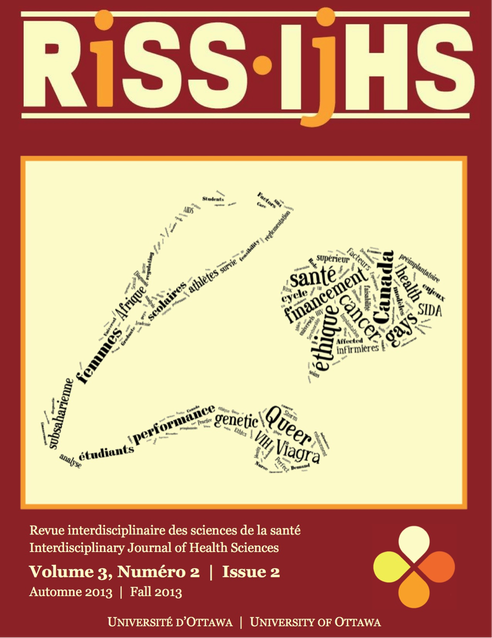Sub-Saharan Women Affected by HIV/AIDS: The Perfect Storm of Risk Factors
DOI :
https://doi.org/10.18192/riss-ijhs.v3i2.1339Mots-clés :
VIH/SIDA, Afrique Sub-Saharienne, femmes, facteurs de risque, sexe, genreRésumé
Cet article examine la santé des femmes dans le cadre de la prévalence et de l’incidence du VIH/SIDA en Afrique sub-saharienne. Les facteurs de risque que la littérature académique suppose comme étant a l’origine de l’augmentation des taux de VIH/SIDA chez les femmes d’Afrique sub-saharienne sont identifiés. Parmi les facteurs de risque abordés, figurent les facteurs biologiques, les parasites, la malnutrition, un faible statut socio-économique, la violence conjugale, la guerre, l’inégalité entre les sexes et le manque d’éducation. Ces facteurs de risque sont liés à plusieurs déterminants de la santé, y compris le niveau de revenu et le statut social, l'éducation et l'alphabétisme, l'emploi, l'environnement physique, le sexe et la culture. Les auteurs présentent leurs points de vue concernant l’endiguement de l’épidémie du VIH/ SIDA, pensant surtout à réduire les effets de la pauvreté chez les femmes d'Afrique sub-saharienne.
Références
Bleich, S. N., Jarlenski, M. P., Bell, C. N., & LaVeist, T. A. (2012). Health inequalities: Trends, progress, and policy. Annual Review of Public Health, 33, 7-40. doi:10.1146/ annurev-publhealth-031811-124658
Campbell, J. C., Baty, M. L., Ghandour, R. M., Stockman, J. K., Francisco, L., & Wagman, J. (2008). The intersection of intimate partner violence against women and HIV/AIDS: A review. International Journal of Injury Control and Safety Promotion, 15(4), 221-231. doi:10.1080/17457300802423224
Feldacker, C., Ennett, S. T., & Speizer, I. (2011). It’s not just who you are but where you live: An exploration of community influences on individual HIV status in rural Malawi. Social Science & Medicine,72(5), 717-725. doi:10.1016/ j.socscimed.2011.01.003
Fox, A., Jackson, S., Hansen, N., Gasa, N., Crewe, M., & Sikkema, K. (2007). In their own voices. Violence Against Women, 13(6), 583-602. doi:10.1177/1077801207299209
Gill, K., Pande, R., & Malhotra, A. (2007). Women deliver for development. The Lancet, 370(9595), 1347-1357. doi:10.1016/S0140-6736(07)61577-3
Greif, M. J. (2012). Housing, medical, and food deprivation in poor urban contexts: Implications for multiple sexual partnerships and transactional sex in Nairobi’s slums. Health and Place, 18(2), 400-407. doi:10.1016/ j.healthplace.2011.12.008
Hallman, K. (2005). Gendered socioeconomic conditions and HIV risk behaviours among young people in South Africa. African Journal of AIDS Research, 4(1), 37-50.
Heimer, C. A. (2007). Old inequalities, new disease: HIV/ AIDS in sub-saharan africa. Annual Review of Sociology, 33, 551-577. doi:10.1146/annurev.soc.31.041304.122203
Himmelgreen, D. A., Romero-Daza, N., Turkon, D., Watson, S., Okello-Uma, I., & Sellen, D. (2009). Addressing the HIV/AIDS—food insecurity syndemic in Sub-Saharan Africa. African Journal of AIDS Research, 8(4), 401-412. doi:10.2989/AJAR.2009.8.4.4.1041
Lauer, H. (2006). Cashing in on shame: How the popular “Tradition vs. modernity” dualism contributes to the “HIV/ AIDS crisis” in Africa. Review of Radical Political Economics, 38(1), 90-138. doi:10.1177/0486613405283319
Mabala, R. (2006). From HIV prevention to HIV protection: Addressing the vulnerability of girls and young women in urban areas. Environment & Urbanization, 18(2), 407-432. doi:10.1177/0956247806069624
Magadi, M., & Desta, M. (2011). A multilevel analysis of the determinants and cross-national variations of HIV seropositivity in sub-Saharan Africa: Evidence from the DHS. Health and Place, 17(5), 1067-1083. doi:10.1016/ j.healthplace.2011.06.004
McInnes, C. (2009). Conflict, HIV and AIDS: A new dynamic in warfare? Global Change, Peace & Security, 21(1), 99-114. doi:10.1080/14781150802659440
Morrison, A., Raju, D., & Sinha, N. (2007). Gender Equality, Poverty and Economic Growth. Policy Research Working Paper 4349. Retrieved from http:// www.development.wne.uw.edu.pl/uploads/Courses/ DW_additional_gender.pdf
Oster, E. (2005). Sexually transmitted infections, sexual behavior, and the HIV/AIDS epidemic*. The Quarterly Journal of Economics, 120(2), 467-515. doi:10.1093/qje/120.2.467
Public Health Agency of Canada. (2011). What determines Health. Retrieved from http://www.phac-aspc.gc.ca/ph-sp/ determinants/#determinants
Rodrigo, C., & Rajapakse, S. (2010). HIV, poverty and women. International Health, 2(1), 9-16. doi:10.101;p’6/ j.inhe.2009.12.003
Sacks, A., & Levi, M. (2010). Measuring government effectiveness and its consequences for social welfare in sub-Saharan African countries. Social Forces, 88(5), 2325- 2351. doi:10.1353/sof.2010.0044
Stillwaggon, E. (2008). Race, Sex, and the Neglected Risks for Women and Girls in Sub-Saharan Africa. Feminist Economics, 14(4), 67-86. doi:10.1080/1354570080226292
Stockemer, D., & Lamontagne, B. (2007). HIV/AIDS in Africa: Explaining the differences in HIV prevalence rates. Contemporary Politics, 13(4), 365-378. doi:10.1080/13569770701822847
World Health Organization, UNAIDS, UNICEF. (2011). Global HIV/AIDS response: Epidemic update and health sector progress towards universal access: Progress report 2011. Retrieved from http://www.who.int/hiv/data/en/
Téléchargements
Publié-e
Numéro
Rubrique
Licence
- Tous les auteurs dont l’article est publié dans la RISS en conserveront les droits.
- Les auteurs accordent à la RISS le droit d’être la première à publier les articles qui lui sont soumis.
- Tous les articles publiés dans la RISS sont autorisés en vertu d’une licence Creative Commons Attribution à être circulé si les auteurs et la revue de la publication originale sont reconnus.
- La RISS est publiée en ligne et imprimée. La RISS n’est pas responsable de l’utilisation non autorisée du contenu publié sous forme électronique ou imprimée.
- La RISS retient les droits de distribution de tout le contenu.
- Les auteurs, et non la RISS, sont responsables d’avoir obtenu les permissions nécessaires concernant les travaux cités.


